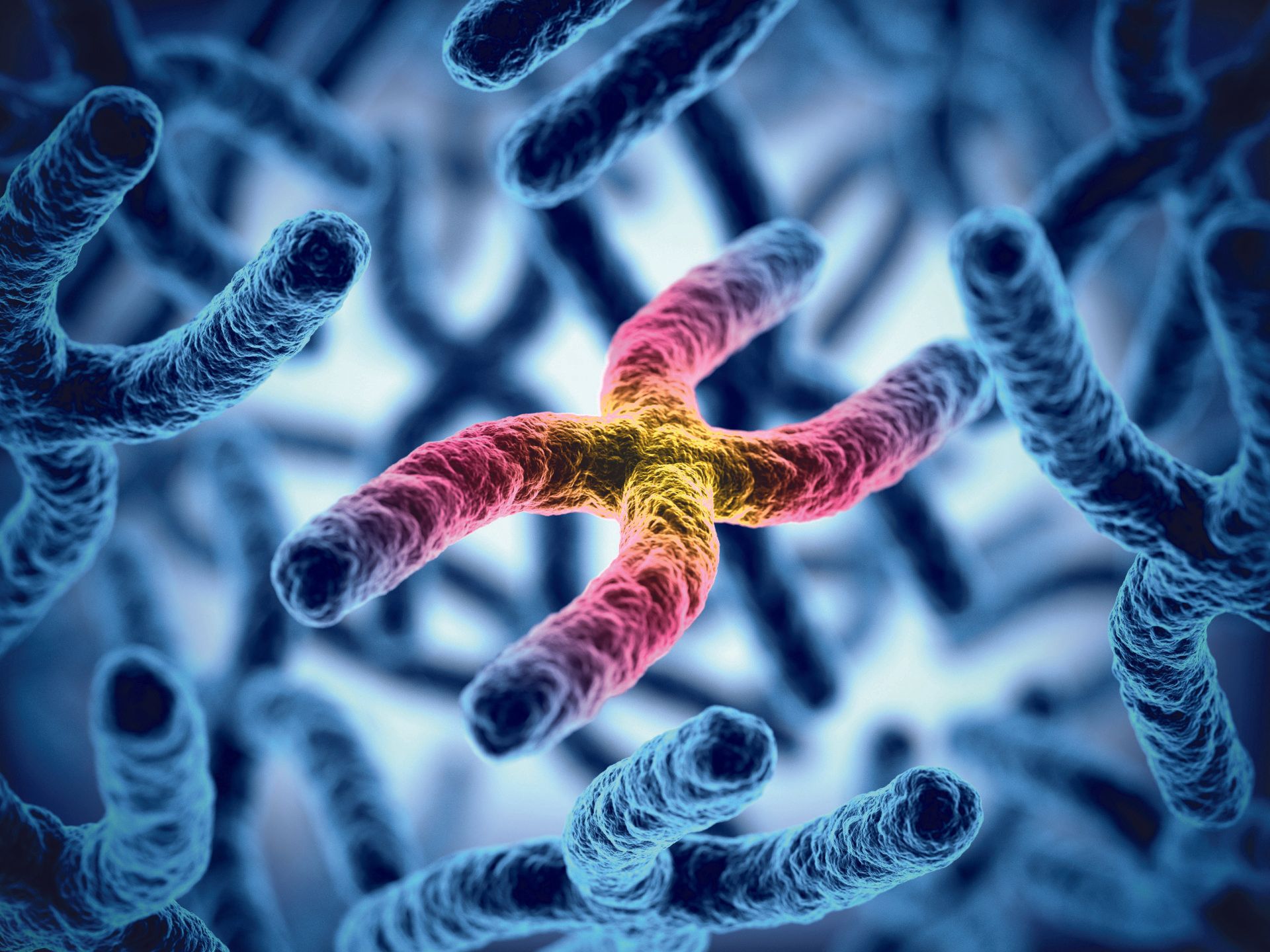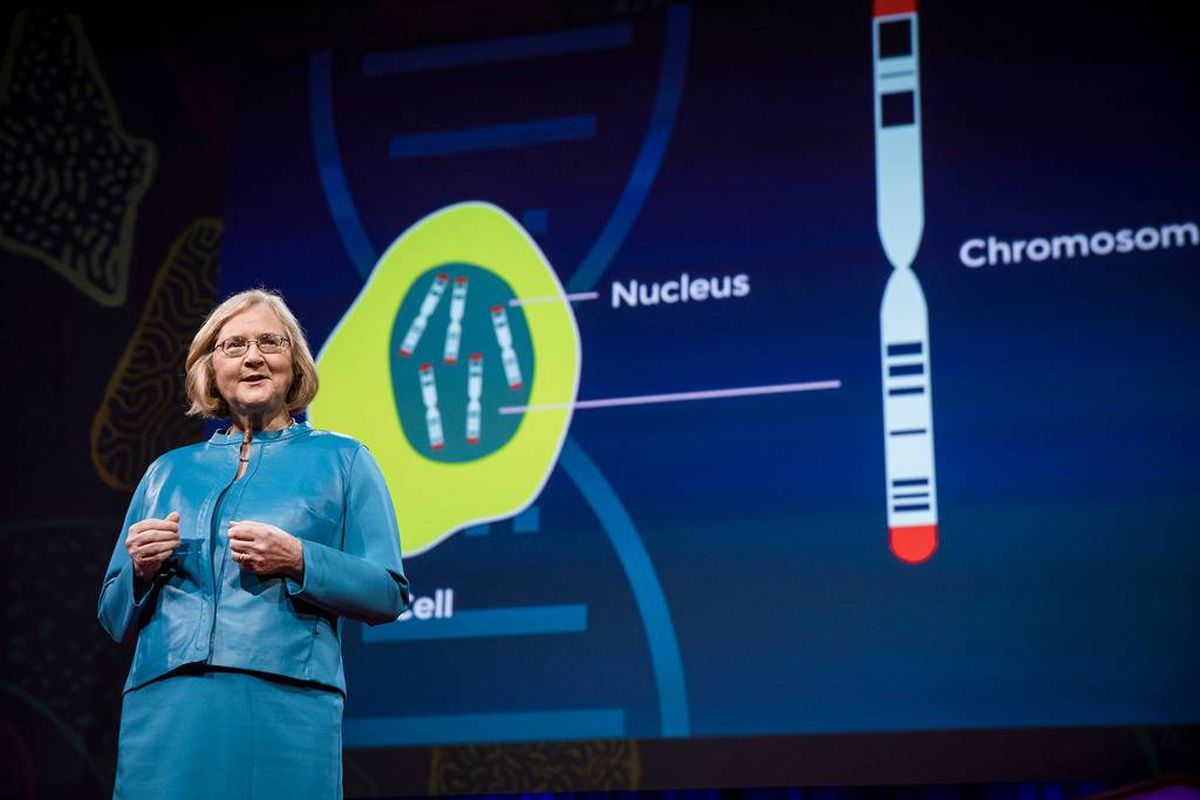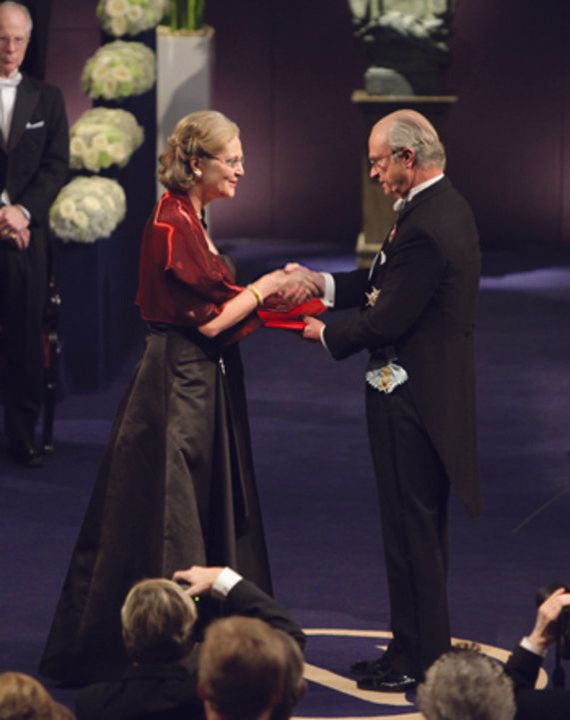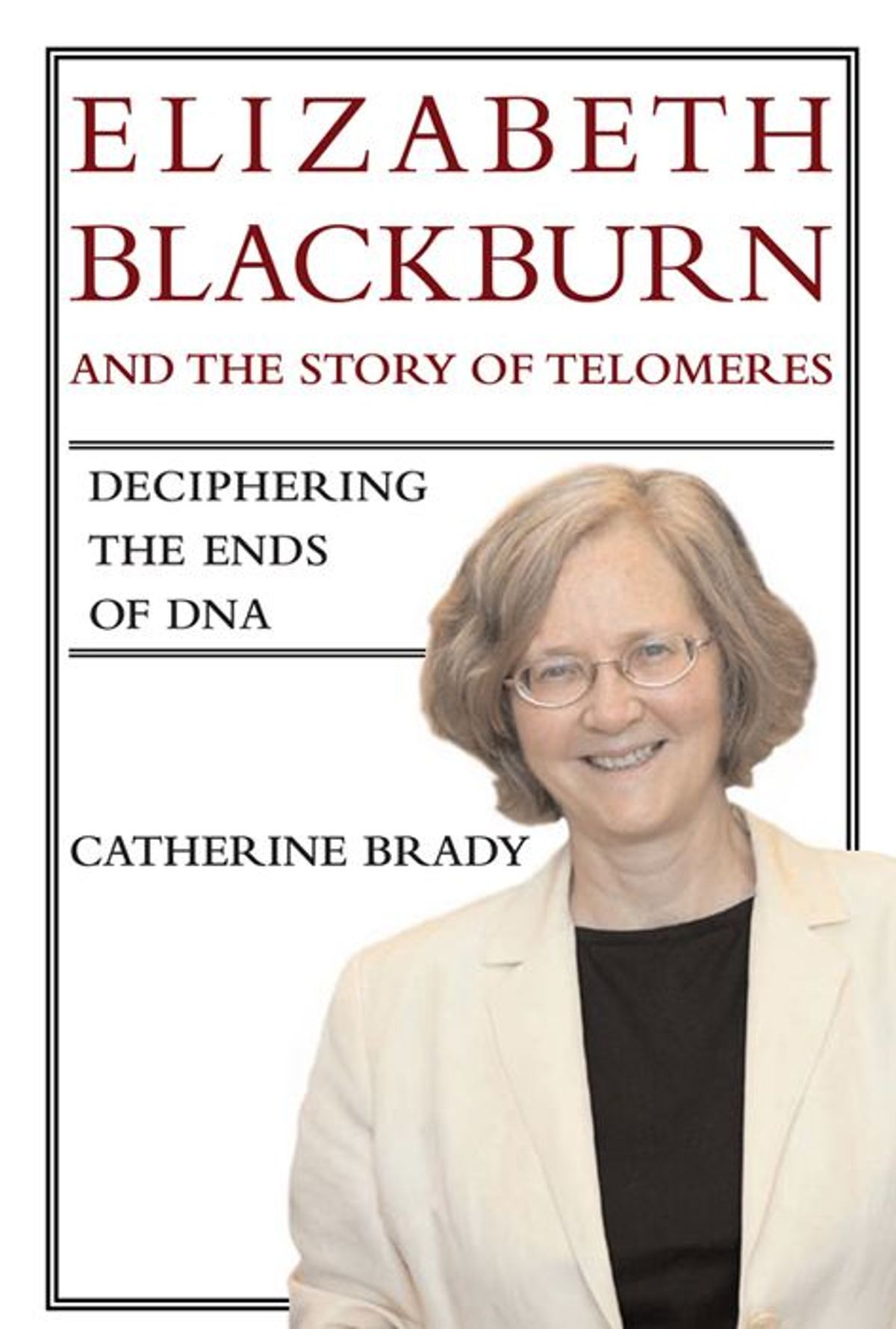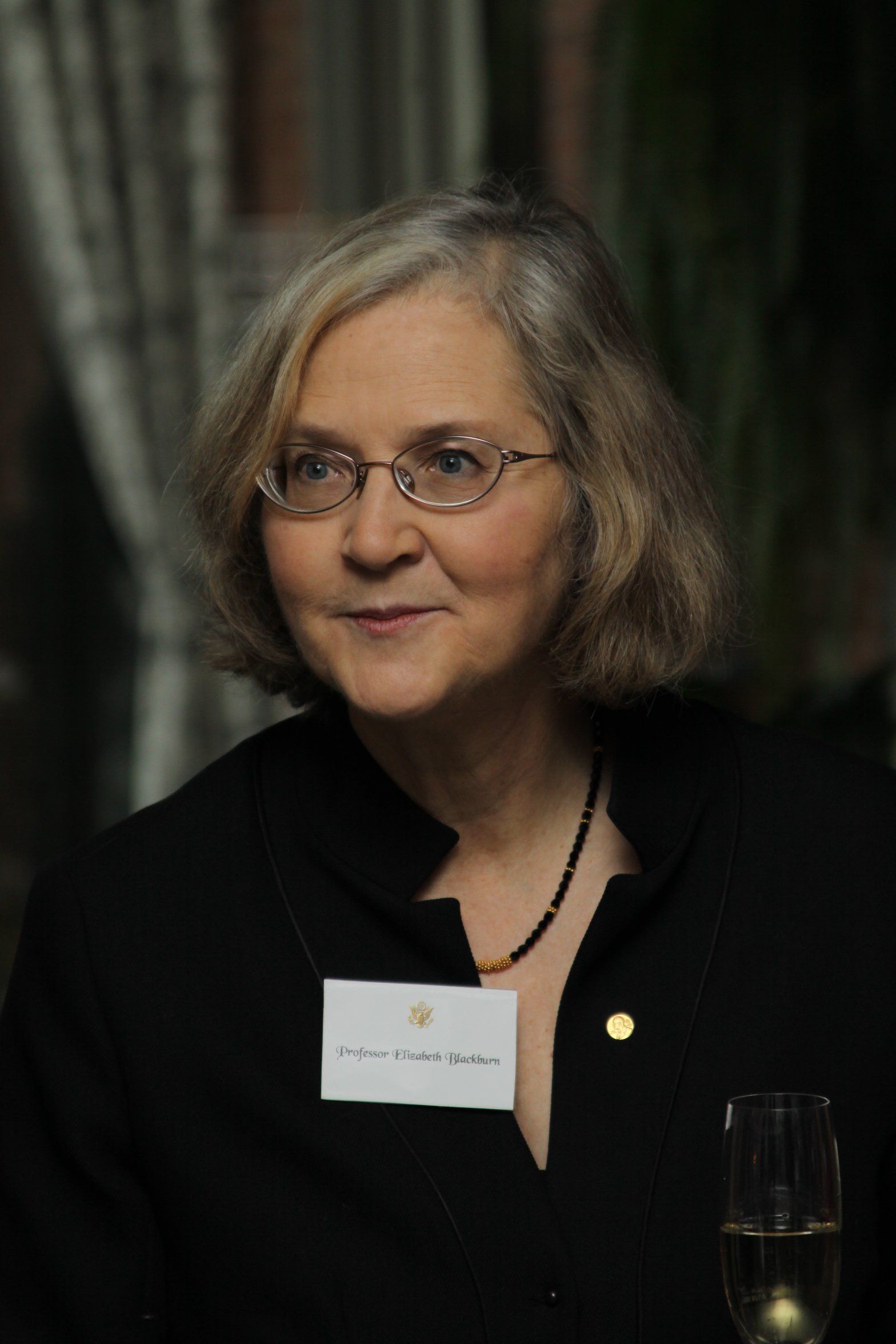The Long and the Short of itBy Deborah Singerman
The Long and the Short of it
By Deborah Singerman
Elizabeth Helen Blackburn 1949-
Nobel Prize in Physiology or Medicine 2009
Balancing the discovery of what protects chromosome length with the downside of its replication of cancerous cells ensures that wishing someone a long life is nor idle salutation to professor Elizabeth Blackburn and her 2009 Nobel Prize-winning collaborators.
Balancing the discovery of what protects chromosome length with the downside of its replication of cancerous cells ensures that wishing someone a long life is nor idle salutation to professor Elizabeth Blackburn and her 2009 Nobel Prize-winning collaborators.
Even as a child growing up in Tasmania, Elizabeth Blackburn’s reading, interests and genes indicated her likely career direction. Budding scientists, as many of the Australian Nobel Laureate biographies show, are curious about life, revel in nature, and, it has to be said, often follow in their ancestors’ footsteps. Blackburn was no exception. Her parents were both physicians, many members of her extended family were doctors, and she cherished the biography of Marie Curie written by Curie’s daughter.
Aware of “this expectation that I’d probably be a physician, it never occurred to me that as a woman I wouldn’t have gone into science,” she says.
In 2009, not only was professor Blackburn the first Australian woman to become a Nobel Laureate, she was the first woman working at the University of California, San Francisco (and fourth UCSF scientist overall) to win the Nobel Prize in Physiology or Medicine. She was also only the ninth woman to win this Nobel Prize. “Very excited” by all this news, she modestly placed herself in context rather than taking all the glory, saying she hoped that “nine will quickly become a larger number”.
The Nobel Assembly at Karolinska Institutet also awarded the 2009 Nobel Prize in Physiology or Medicine to collaborators Dr Carol Greider of the Johns Hopkins University School of Medicine and Dr Jack Szostack of Harvard Medical School. Their discovery of how chromosomes are protected by telomeres and the enzyme telomerase revealed that a unique DNA sequence repeated several times in the telomeres protected the chromosomes from degradation. In effect, the long, thread-like DNA molecules that carry our genes became protective caps at the end of chromosomes.
This DNA sequence varies between species. Blackburn had long been fascinated with “small living creatures”, which she loved to hold and even sing to, leading her toward biochemistry “as a doorway into the mystery of how life worked” and, more specifically, to a single cell organism called Tetrahymena that lives in water. This “odd-ball creature” she told assembled dignitaries in her Nobel banquet speech, has seven sexes. “Who knows what is going on under the dark surface of the pond?” she surmised mischievously.
Blackburn also acknowledged the prize-winners’ journeys, both professional and geographic. She has lived in the United States for well over 30 years and has dual Australian-American citizenship. She lived in England as a student for several years, too. Szostack and Greider have mixed Canadian, US and United Kingdom credentials. They also have science in their blood, Greider being the daughter of two scientists with doctorates from the University of California, Berkeley, and Szostak, the son of an engineer-father. Theirs was also a long partnership - no fly-by-nighters here. Blackburn had known Szostack and Greider for decades and conducted experiments with them after her early study of telomeres as a postdoctoral fellow at the 1975 Yale University of the founder of telomeres research, Joseph Gall. The groundbreaking work on telomeres and telomerase is recounted in academic, Nobel, medical and popular media. The term telomere was coined in the 1930s by researchers Barbara McClintock (Nobel Prize 1983) and Hermann Muller (Nobel Prize 1946), who noticed that the ends of chromosomes appeared to have a protective role. Without these ends, the chromosomes became sticky, fusing together and breaking down. The Greek telos (end) was joined by meros (part). Telomere experiments in single-cell Tetrahymena contained relatively short linear DNA sequences (minichromosomes) which meant that large amounts of this type of genetic material could be isolated. On analysing the ends of the minichromosomes, the telomeres, Blackburn found a shortened sequence, CCCCAA, which was repeated 20 to 70 times. The DNA sequence was replicated in an unusual way, but was later added to the end of the chromosomes.
EXPERIMENTING ACROSS SPECIES
How did this happen? Blackburn described her findings about Tetrahymena at a scientific conference in 1980 and Szostak, who was trying to find out how minichromosomes functioned in yeast, suggested that he and Blackburn try an experiment crossing both species. The research asked whether the telomere sequences from Tetrahymena protect minichromosomes from being broken down in yeast. Their results have had profound implications.
Blackburn determined that this sequence could be added to chromosomes, and with Szostak began the experiment that they thought would probably fail. Although the Saccharomyces cerevisiae (baking and brewers yeast) they worked with was unrelated to telomere, they found they could use the Tetrahymena sequence to stabilise a long strand of DNA. Szostak’s group identified yeast cells with mutations that gradually shortened the telomeres, and eventually stopped dividing. Blackburn’s team made mutations in the RNA of the telomerase and noted similar effects in the Tetrahymena, again leading to premature cellular ageing - known as senescence. Functional telomeres, on the other hand, prevent damage to chromosomes and delay cell ageing. Greider’s group later showed that telomerase delays the ageing of human cells. The telomere DNA sequence attracts the proteins that form a protective cap around the fragile ends of the DNA strands telomeres prevent the loss of essential genetic information from the chromosome.
Blackburn describes them as being like the plastic ends of a shoelace. Over time, the telomere’s stability diminishes to a shortened state where it cannot protect an organism from disease. As a result, cells age and shut down. Their chromosomes may fuse or rearrange mutations that can lead to cancer. These ends (called telomeres) get shorter each time a cell divides. They must possess a special enzyme that added these repeat units to the end of chromosomes so as to compensate for the incomplete job done by the copying enzyme. Working in Dr Blackburn’s lab as a graduate student, Dr Greider tracked down this enzyme, now known as telomerase, in a central experiment that finished on Christmas Day, 1984. Going into the lab that morning, Greider saw from the six-unit repeat that she had captured telomerase. “That was a really exciting day,” she said. “We tracked the enzyme over time and saw it going up and down at the right time, and the pattern was right, so we knew the enzyme was influencing telomere production,” Blackburn added. Yet, another 15 years passed before the highest level of international recognition- the Nobel Prize. Greider and Blackburn later found that as well as containing protein to do the building work, telomerase has a special piece of RNA that it uses as a template to elongate the chromosome with the six-unit repeats (the CCCCAA sequence). Telomerase extends telomere DNA, and enables DNA polymerasers to copy the length of the chromosome right to the end. Telomerase is usually active only at the beginning of life; thereafter the telomeres get shorter each time a cell divides. If they get too short, a cell is thrown into senescence (premature ageing), meaning that it cannot divide again. Short telomeres are known to have a role in certain diseases of ageing, like aplastic anemia, where bone marrow does not produce sufficient new cells to replenish blood cells. Telomeres are also important in cancer, a disease in which control of cell proliferation is lost. Telomerase elongates telomeres in cancerous cells of advanced tumours making it a target within these cells.
Cancer cells need to reactivate the telomerase gene, or their telomeres will get steadily shorter, forcing them into senescence. In some 80 to 90 per cent of human cancer cells, the telomerase gene has been switched back on, Blackburn said, this activity preventing them from losing their telomeres. Telomere length may not yet be as well known as monitoring cholesterol or blood pressure bur it is entering the vernacular. SBS documentary maker, Sonia Pemberton, made Secrets of the Human Body: Immortal (December 5 2010), showing the viewing public how telomeres and telomerase held the balance between, as SBS described it, the “power to extend life, and the ability to destroy it”. She had her telomere measured and it was the length of someone five years her senior. She vowed to do more exercise, which research, discussed later, has shown can counteract the impact of stress, for instance, on telomere length. An article on ageing gracefully by Sydney Morning Herald health contributor, Paula Goodyer, mentioned “intriguing research into the impact of exercise on things called telomeres” (without mentioning the Nobel Prize winner).
NICE GIRLS DO SCIENCE
Blackburn was discouraged by people who said nice girls do not do science bur, knowing her destiny, she persevered and gained Bachelors and Masters degrees in science at the University of Melbourne. Like her mother, Marcia, she was a resident of Janet Clarke Hall, Australia’s first university college to admit women. “Those in college at the time describe her as balanced, fun and adventurous,” the university says in an official statement. “She played the piano, enjoyed camping, was keenly interested in people, and was not necessarily one to study late into the night- she was too organised for that.” A mentor at Melbourne, Frank Hurd, urged her to go to Cambridge University where she worked as a postgraduate student with English biochemist, Fred Sanger (he won his second Nobel Prize in Chemistry in 1980). In Sanger’s lab Blackburn met her future husband, John Sedat, who was then a postdoctoral student. Sedat took a job at Yale University in 1975 and Blackburn found the lab work there - and the species- which were to change her life. “I did a postdoc at Yale with Joe Gall, who had discovered a class of very tiny linear chromosomes in a type of singlecelled protozoa. These creatures (the Tetrahymena)they are pond scum, literally- had lovely, accessible chromosomes. And I thought, ‘Oh, wonderful. I’ll sequence these.’ And right away, I found these strange molecular features about their ends: telomeres.” She and Sedat moved again in 1977, when he got a job at University of California (UC), San Francisco (he is professor of biochemistry and biophysics at UCSF). She soon was hired as an assistant professor in the department of molecular biology at UC Berkeley. For the first time, she had her own lab. Scientists in the Netherlands had observed that the telomeric DNA fragment would get longer and longer. Blackburn suspected there must be an enzyme. “When I got tenure at the University of California at Berkeley in 1983, I got brave and starred thinking about entering a whole new era of research, and so began the hunt for that enzyme activity.” She had noted that other scientists with a molecular focus were also intrigued by the ends of chromosomes which went against more common understanding about how DNA strands could be copied without losing parts of their ends. And it was there on Christmas Day in 1984 that Greider made that fateful discovery of telomerase.
“The huge luck of being in academic research is that you can let yourself learn from the results you get,” Blackburn says. “If you’re on a freewheeling ride like I am, there are no dead ends, because there’s always something new to investigate. I don’t have dead ends. Isn’t it wonderful? “I adhere to basic science but then you have to branch out into arcane avenues, to experiment where you may not be sure of the outcome but you have to give it a go.
Now I’m old enough to say, dammit, I really did have the smarts to take advantage when I saw certain things.” She has been the Morris Herzstein professor of biology and physiology at UC’s San Francisco campus since 1990, as well as a non-resident fellow of the Salk Institute. As well as being attracted to the university by the promise of the latest equipment and a top team, it fitted in with her need to rest after going into premature labour with her son, Ben. She ran the Berkeley lab long distance, juggling roles as a parent and lab scientist. The “constant tussle” and commuting to Berkeley tired her out, hence her move to UCSF in 1990, allowing her to spend more time with her family. Blackburn has had periods of self-doubt and fear, she says, and “was very much daunted and overcome by the challenges of finding jobs. You have to kind of be tough,” she said of weathering those disappointments. In reflecting with UCSF chancellor, Sue Desmond Hellmann, on her career, in front of students from the university and local high schools, Blackburn said that while work-life balance was a worthy long-term goal, it was not something that can be accomplished and maintained all the time. “I understand family and career balance ... and I think it can be over the years that the balance can be achieved, but not every single day necessarily,” she said. The study of telomeres is notable as a field of research in which female scientists are particularly prominent. Greider ascribes this to a “founder effect” (namely Gall of Yale University who trained Blackburn and other women, who, in turn, recruited others to the field). “There is a slight tendency for women to work with other women,” she says. Blackburn also feels “women bring in more women and they feel comfortable”. Her own achievements help people visualise themselves in science, she says, but she recognises that something akin to the “aggressive” anti-smoking campaigns might be necessary for real progress for women in science. In her own life, she and Sedat have prioritised different things at different times. When Ben was growing up, for example, the couple “just focused on science and family” and waited until he had left the fami ly home before resuming visits to the movies, restaurants and such like, she said. She is a great believer in raking breaks and unwinding - to “work hard, play hard”. “Having intense relaxation is very important, such as traveling or something where you turn your mind off, “ she says. In May 2007, when Time magazine named Elizabeth Blackburn as one of the year’s “100 Most Influential People in the World,” it listed her age as 44, much younger than she was. “Don’t think I’m going to ask for a correction on that one,” Blackburn said, “If they want to turn back the clock, that’s lovely.”
HEALTH IMPLICATIONS
Stress can have effects similar to ageing in reducing telomerase. Blackburn and colleagues have found telomere erosion in people who suffer chronic stress. They are working on longer-term studies to see if lifestyle interventions - diet, exercise and stress reduction -will promote telomere repair, perhaps staving of damage and illness from coronary artery disease or diabetes, for example. “The idea is that wow, inside your cells, your molecular machinery is wearing down and this is not good,” Blackburn says. “If you can get a kind of science that is easier for people to grasp, a concrete measurement aspect, maybe this is the way to change policy.” Spurred on by evidence that physiology can help to make people healthier, she has teamed up with psychologists and doctors to investigate how such interventions might make you feel better and have longer term genetic implications. “We have this huge problem, which is all this morbidity and disease in the middle part of life”, she warns. Telomere length may decline overall, but it varies between individuals. Long or relatively long telomeres is the goal. Blackburn, who reportedly only complains about an “achy back”, applies what she considers good science to her own life. She eats a low fat diet and takes time to relax, exercise and walk with Sedat. She is also collaborating with Elissa Epel, an associate professor in the UCSF Department of Psychiatry. They are studying two groups of mothers - one with normal healthy children, the other with children with chronic illness - and have found the longer caring for the chronically ill children the less the mothers’ telomerase and the shorter their telomeres. “Most basic biologists like her stay very focused,” Epel said, adding that it was unusual for biologists like Blackburn to branch into “translational research. “It’s risky to branch into fields you know little about.” A study of men with prostate cancer, run by “lifestyle guru” Dr Dean Ornish at the Preventive Medicine /Research Institute, was monitoring the effectiveness of interventions in protecting against the growth of prostate cancer. “What we eat and how we respond to stress and whether we smoke and level of intimacy makes a difference, even on a genetic level,” Ornish says. Blackburn frequently cautions that so-called “magic pills” have a habit of “ biting back” with unexpected and unwanted side effects.
“We’ll want a drug therapy. But in a way it’s sort of stupid not to use millions of years of your body’s physiology. If you can persuade your body physiology to do this for you, do it. It’s free.” A Good Weekend article on Women of Influence listed “the Australian-born American biological researcher Blackburn” as an Innovator (as was the Australian Academy of Science’s Suzanne Cory, one of this book’s Women in Science). If her visit to Australia after winning the Nobel Prize is anything to go by, she is in constant demand from organisations and academic institutions. Her visit to Questacon in Canberra was organised by the office of the chief scientist, who at the time was professor Penny Sackett, and the Prime Minister’s Office. Ensuring no-one will forget Blackburn’s achievement, Questacon director Graham Durant said they named “our new boardroom in her honour as the Blackburn Room”. She also gave lectures at Melbourne University and a public lecture on telomerase and telomere biology at the University of Sydney, March 12 2009, at the invitation of leading professional bodies – the Australasian Association of Clinical Biochemists, the Human Genetics Society of Australasia and the Royal College of Pathologists of Australasia. More recently, professor Blackburn’s busy timetable resulted in an email for the book: “I regret to have to tell you that I am overwhelmed and not doing any further interviews- by email or otherwise -right now”. However, there are consistent portrayals of her by others, showing a straightforward approach, rapport with students and passion for science. Says Sackett: “If the focused intensity in the eyes of the younger children and the rapt attention and razor sharp questions posed by the older students were any indication, professor Blackburn’s interaction with them will be a formative experience for them as they continue to think about science. It certainly would have been for me at their age.
“Professor Blackburn has an easy manner and is able to describe her science and its significance at any level. But perhaps more importantly, she is able to convey why she is so passionate about doing science and thinking about science. She spoke about her own journey of curiosity from a small age, and described science as a creative activity, one that benefits from daydreaming as well as from discipline. “We all can learn to see science in the world around us, understand how science alters our lives, and thus appreciate the world (and science) just a little bit more in the process. Those who study science in depth, however, or take it up as a profession, have an even greater opportunity: the chance to embark on a life-long journey of discovery with nature. The destination is not always clear, but the trip is fun, challenging, and often makes you forget entirely that you can actually be paid to make discoveries and make a difference at the same time.” Speaker of the United States House of Representatives at the Nobel Prize time, Nancy Pelosi, called Blackburn a “champion of innovation” and “an inspiration to all women pursuing careers in the fields of technology, engineering and mathematics”. Then California governor, Arnold Schwarzenegger, said, “You are fantastic, and you are one of those immigrants that is making great contributions to the State of California.” University of Melbourne went from 75 to 62 after Blackburn’s award, recording the biggest increase of any university in the top 100, in the Shanghai Jiao Tong rankings. The Governor-General Quentin Bryce, when presenting professor Blackburn with her AC (Companion of the Order of Australia) during the post-Nobel Prize visit, was particularly moved. “I just had tears going down my cheeks as I was putting it around her neck because I was telling her about my memories about the girl from the little town I came from who was the first in the town to do science. It was in the 1940s and her name was Sanna Shannon and we all spoke of it as if she was going to the moon.” “She’s scary in the right way,” says Kerry Hegarty, managing director and chief executive of Sienna Cancer Diagnostics, a small Melbourne-based biotech company that has the global intellectual property rights to telomerase. Intellectually uncompromising, Blackburn is very supportive of those whose work is strong. “She’s a fantastic mentor and her enthusiasm for this field of science is contagious,” says Hegarty. She is also prepared to fight for her scientific beliefs, such as the advancement of embryonic stem cell research. In 2001, President Bush appointed Blackburn to the Bioethics Advisory Council. Three years later, to the consternation of many fellow scientists, she was kicked off because she disagreed with a ban on therapeutic cloning. Reports at the time praised her for not avoiding the controversy, on the one hand, but also, on the other, keeping away from the limelight. She was said to me more comfortable in the lab. Another forthright commentator, immunologist and 1996 Nobel Laureate Peter Doherty (see Survival of the cells) agrees. “She’s direct. She doesn’t beat about the bush,” and she is “all around an admirable person ... and identifiably Australian. She was always a star. She’s won all the prizes and hit all the marks since she was quite young.” Her husband, Sedat, affirms that life with her is well-rounded. “There is no question that one of the nice features of Liz is that she’s shown young women scientists that you can make it and also have a family, that it’s not one or the other, and that it’s fun,” he said. “You go home at night and feel like there are some interesting new ideas, even after you’ve been doing it for 30 years.” As with all discoveries, what ultimately matters is long-term impact. The Nobel Assembly at Karolinska Instituter concluded that the work of Blackburn, Greider and Szostak “added a new dimension to our understanding of the cell, shed light on disease mechanisms, and stimulated the development of potential new therapies”. Keeping telomeres intact and protecting the ends of the chromosomes that brim with our DNA carrying genes is still a beautiful dance for this eminent scientist.
Vital statistics
Name: Elizabeth Helen Blackburn
Born: November 26 1948 in Hobart, Tasmania
Parents: Harold Blackburn and Marcia Jack
School: Broadland House Girls Grammar School, Launceston
University: University of Melbourne BSc (1970), MSc (1972); University of Cambridge PhD molecular biology (1975); post-doctoral work in molecular and cellular biology, Yale University (1975-77)
Married: Jack Sedat, April 24 1975
Children: One son, Benjamin
Lived: Tasmania, Melbourne, Cambridge (UK) and California, since mid-1970s
Awards and Accolades:
1990: Professor of Microbiology and Immunology, Morris Herztein Professor of biology and Physiology, and
Biochemistry and Biophysics, University of California San Francisco
1991: Fellow of American Academy of Arts and Sciences
1992: Fellow of Royal Society UK
1993: First woman chair of Department of Microbiology and Immunology University of California San Francisco; Foreign Associate National Academy of Science Award in molecular biology, National Academy of Science; Fellow of American Academy of Microbiology
1998: President of American Society of Cell Biology
1998: The Gairdner Foundation International Award
1999: California Scientist of the Year
2000: American Cancer Society Medal of Honour; Fellow of American Association for the Advancement of Science; Member of Institute of Medicine
2002-04: President’s Council on Bioethics
2006: Albert Lasker Medical Research Award in Basic Medical Research Award in Basic Medical Research; TIME magazine list of 100 most influential people
2008: Tasmanian Roll of Honour
2009: Nobel Prize in Physiology or Medicine
2010: Companion of the Order of Australia (Australia Day Honours) for eminent service to science as a leader in biomedical research
2010: Genetics Prize from Peter Gruher Foundation
2010: President of American Association for Cancer Research
Why She was awarded the Nobel Prize:
Elizabeth Blackburn was awarded the 2009 Nobel Prize in Physiology or Medicine, sharing it with Carol Greider and Jack Szostak. She studied the telomere, a structure at the end of chromosomes that protects the chromosome, and co-discovered telomerase, the enzyme that replenishes the telomere. The Blackburn Lab researches the synthesis and function of telomeres and the mechanism of telomerase action and its role in cells. Their discovery of how chromosomes are protected by telomeres and the enzyme telomerase revealed that a unique DNA sequence repeated several times in the telomeres protected the chromosomes from degradation. In effect, the long, thread-like DNA molecules that carry our genes became protective caps at the ends of chromosomes. Short telomeres are known to have a role in certain diseases of ageing and are also important in cancer. Telomerase elongates telomeres in cancerous cells of advanced tumours making it a target within these cells. She is now looking at the effects of stress in reducing telomerase and is working on longer-term studies to see if lifestyle interventions – diet, exercise, and stress reduction – will promote telomere repair.

